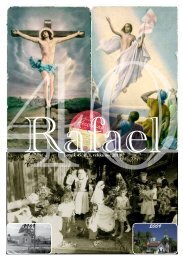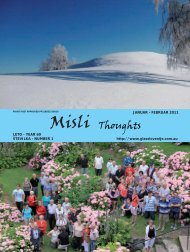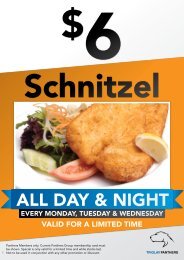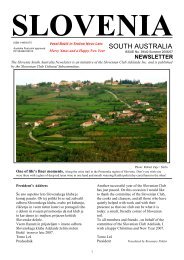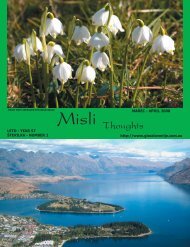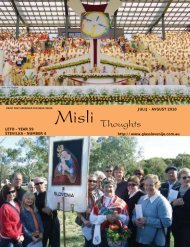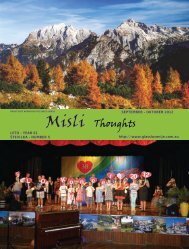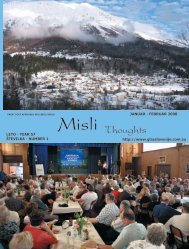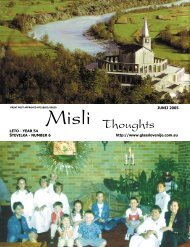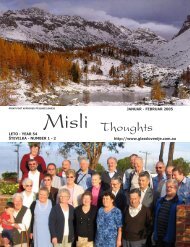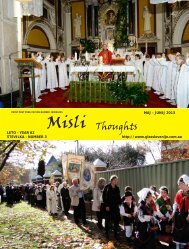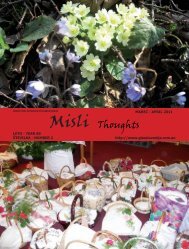The voice- - Glas Slovenije
The voice- - Glas Slovenije
The voice- - Glas Slovenije
Create successful ePaper yourself
Turn your PDF publications into a flip-book with our unique Google optimized e-Paper software.
<strong>The</strong> <strong>voice</strong>-Year 3/No 29-30February March 2003Of SloveniaSlovenians Vastly in Favour of EU and NATO<strong>The</strong> strong support for the EU and NATO thrilled Slovenia’stop officials. President Janez Drnovšek called the outcome the “crownof a decade long effort”, while Foreign Minister Dimitrij Rupel believedthe citizens, wise and prudent, grabbed an historic opportunity.Meanwhile, Prime Minister Anton Rop pointed out that a lot remainsahead of Slovenia, before it actually joins the EU and NATO. EuropeMinister Potocnik was certain the “yes” vote to the EU confirmsSlovenian’s sense of belonging to Europe. As to the acceptance of theNATO invitation, Defence Minister Anton Grizold believes that Sloveniawill be a credible partner in NATO.<strong>The</strong> President of the European Parliament Pat Cox arrived inSlovenia especially to celebrate the “yes” vote of the EU referendum.He congratulated Slovenians at an event staged by the European Commissiondelegation to Slovenia, where Speaker of the Slovenian Parliament,Borut Pahor, and EU Ambassador Erwan Fouere rejoiced in theoverwhelming support for the EU. <strong>The</strong> representative of the Greek EUpresidency, charges d’affaires Ioanna Efthymiadou, welcomed Sloveniato the European family. <strong>The</strong> outcome was also hailed by NATO SecretaryGeneral George Robertson, the European Commission, and otherforeign officials.Knotty Path Towards ReferendaAlthough nearly all parliamentary parties have backedSlovenia’s accession to the EU and the Alliance - opposing NATO membershipare only the opposition Youth Party (SMS) and National Party(SNS), while the latter is also against membership of the EU - the pathtowards the referenda was not as smooth as one would expect. <strong>The</strong>government and the opposition launched negotiations over the date andthe form of both votes right after the New Year.<strong>The</strong> government initially suggested both referenda should beconsultative in form and held as early as February 9, but the largesttwo opposition parties - the Social Democrats (SDS) and New Slovenia(NSi) - did not agree with the idea that the results of both votes wouldnot be formally binding. As the government decided that the referendumon NATO should be held before the end of March in view of theAlliance’s expectation that Slovenia would give a clear answer to thePrague invitation to join NATO before the Accession Protocols aresigned on March 26, the ruling coalition was pressed for time and thereforefiled an initiative itself to call the referenda in mid-January.However, negotiations continued with the opposition SDS and NSi(which support membership of both the EU and NATO) and they eventuallyresulted in constitutional changes. <strong>The</strong>se not only pertained tothe referenda, but chiefly to the so-called “European clauses” amendedin light of the country’s accession to the EU. <strong>The</strong> implementation partof the constitutional act set down that the March 23 referenda are legallybinding and cannot be repeated in case of a positive outcome. Itfurther stipulated that the referenda can be participated in by Sloveniancitizens abroad, and that invalid votes would not count as no votes aswas the case in referenda so far.By way of these changes, the government secured the importantsupport of the two opposition parties in the continuation of thereferendum campaign.At Home in Europe, Safe in NATOThis was the slogan of the referendum campaign in whichthe government tried to persuade the people to vote for accession intothe EU as well as NATO. <strong>The</strong>re was no doubt that Slovenian voterswould back membership of the EU as there were steady high publicapproval ratings for the Union. NATO was another story. Public opinionwas divided and, in mid-February, the number of advocators inopinion polls was almost on a par with the number of opponents, whilealmost one third of voters were still undecided. While government officialswere only lukewarm in persuadingSlovenian voters surprisinglyand overwhelminglybacked the country’s EUand NATO memberships atreferendums. According tounofficial results, NATOsupport stood at 66.18 percentwhile EU backing, at89.66 percent, surpassedeven that of the independencevote in 1990. <strong>The</strong> turnoutstood at 57.92 percent;33.82 percent of the electoratevoted against NATO,while EU was disapprovedby 10.34 percent.the voters of the benefits of NATO membership for Slovenia, and evenmade some errors that contributed to a decline in support for NATO,the opponents were quite active.<strong>The</strong> situation reversed in early March; the government beganto promote arguments in favour of NATO in a more aggressive mannerand, in the face of the impending war in Iraq, tried to make peopleunderstand that NATO was not the same as the United States. <strong>The</strong>government was assisted by a number of senior representatives of bothorganisations, and top officials from member countries of the EU andNATO, who literally followed on each other’s heels to Ljubljana duringthe first two weeks of March. <strong>The</strong> efforts bore fruit and, a weekahead of the referenda, it was all but clear that Slovenians would alsoback membership of NATO.<strong>The</strong> government is said to have spent SIT 128 million (EUR0.55m) for the referendum campaign, while the main reproach of thoseopposing NATO membership was that they did not get any financialresources for their campaign from the government, and that the campaignwas therefore one-sided.EU and NATO Long-Term Foreign Policy GoalsSoon after declaring independence, Slovenia made it its goalto join the EU and NATO, so the National Assembly set down thesetwo strategic objectives in several documents. Yet the path was not freefrom impediments and disappointments.Slovenia asked for associate membership of the Union as earlyas 1992, which is the year it won international recognition, but it wasnot able to sign the Association Treaty until 1996. Before signing, thecountry was forced to submit to the demands of one member, i.e. Italy,and accept the so-called Spanish compromise requiring it to open itsproperty market. <strong>The</strong> accession negotiations with the 15-nation blockicked off in 1998. <strong>The</strong> negotiations over 31 chapters wrapped up lastDecember. While the first part of the talks mainly discussed Slovenia’sadoption of European legislation, the final phase focused on financialissues.Slovenia had expected an invitation to join NATO as early asthe Madrid summit of 1997, but that expectation turned into bitter disappointment.At the time, the Alliance only extended its invitation tothe Czech Republic, Hungary and Poland; Slovenia, together with Rumania,had to make do with a vague promise of the Alliance’s futureenlargement. In the face of the Madrid setback, politicians were carefulwith promises thereafter and meanwhile, opposition to NATO membershipstarted to grow among the public. Slovenia co-operated withNATO within the Partnership for Peace programme, and began implementingthe Membership Action Plan after the 1999 Washington summit.Slovenia was officially invited to join the Alliance at the NATOsummit in Prague last November.What Next?Neither the EU nor NATO required Slovenia to stage the referendaon membership; rather it was the decision of Slovenian politiciansin a bid to get a mandate from the voters before the final decisionsare made.Together with the other accession countries, Slovenia will signthe Accession Treaty with the EU in Athens on April 16. This will thenhave to be ratified by the parliaments of all the incumbent, as well asfuture members. Slovenia is expected to join the EU as a full-fledgedmember on May 1 2004.In May of next year Slovenia is also expected to become amember of the North Atlantic Treaty Organisation. <strong>The</strong> signing of theAccession Protocols on March 26 will be followed by the ratificationprocess in all NATO members and the parliaments of the invited countries.When the procedure wraps up - expectedly before the next NATOsummit in May 2004 - Slovenia and six other countries will enter theAlliance. Slovenian language and culture – the Future.
2February March 2003Vladimir Bartol, the author of one the most widely translatedSlovenian novel, Alamut, would celebrate his 100th birthday onFebruary 24. When it was first published in 1938, Alamut wasreceived with considerable scepticism by critics. Now, decades later,critics and readers alike talk about it with nothing but superlatives.Bartol was born in 1903 in a small villagenear Trieste into the family of a postoffice worker, Gregor Bartol. His motherMarica was a teacher, writer and the editorof the first Slovenian women’s magazineSlovenka. While his mother laterlargely renounced her feminist views inpractice, the young Vladimir was adamantto pursue his dreams and become a writer.Not just any writer, but a world famousman of letters. <strong>The</strong> undeterred self-confidencethat he showed as a youngster later helped him weather thestorm of criticism that he was exposed to due to his life philosophyand writing. <strong>The</strong> family decided to move to Ljubljana whenVladimir was in secondary school. After finishing school in 1921,he went on to study biology and philosophy, and graduated with athesis entitled On Factors that Enable Living Organisms to ReactReasonably to External Impulses.<strong>The</strong> Formative YearsWhile at university, Bartol made friends with the youngphilosopher and alpine climber Klement Jug. Jug was a ferventbeliever in Nietzsche’s “will to power” and, unlike many otherphilosophers, he actually practiced what he preached. He undeniablyaffirmed his philosophy of an uncompromising rise of willpowerwhen he died climbing the excruciating northern face ofMount Triglav, Slovenia’s highest mountain, in 1924. Jug left anindelible impression on Bartol, the ultimate result being that hisopponents too often criticised him as a philosopher and ideologist,and forgot about his literary work.In the concept of “will to power”, Bartol found what heperceived as being the elementary characteristic that a small andthreatened national group like Slovenians need in their struggle topersevere. He was sharply critical as he discovered in Sloveniansthe characteristics of a weakened nation, brought up in humilityand fear of living. It was a nation defined by the cult of goodness—a goodness unfortunately, of the feeble.In a short story entitled “At the Crossroads” (1935), whereone of the characters can easily be recognised as modelled onKlement Jug, Bartol says: “Bunglers achieve nothing. Our nationhas always been a nation of bunglers and a friend of compromise”.Although this was a veiled call for a rise to arms in a nationalliberation struggle, the established intellectual elite started treatingBartol with considerable criticism; even more so after he publishedAlamut three years later. Bartol initially wanted to dedicateAlamut to an “unknown dictator”, but the editors nipped his intentionin the bud.AlamutSet in Persia in the 11th century, Alamut is the story ofHassan Ibn Sabah, an old man who becomes the head of theAshashini sect. Ensconced within his mountain citadel of Alamut,the “Caligula of the East” wages a horrifying holy war against theTurks who threaten to impose Sunnitism on the Persian Muslims.At first, Hassan Ibn Sabah seems week and undermanned comparedto the superior enemy. Yet he achieves a breakthrough witha small but utterly committed group of fedayee. <strong>The</strong>y are fanaticdesperados fearless of death. He gets them high on hashish, givesthem a taste of what they believe to be heaven, and sends them tosuicide missions they are eager to fulfil.Vladimir Bartol: Far Ahead of His Time<strong>The</strong> character of Hassan IbnSabah was strongly reminiscent of thelikes of Hitler, Mussolini and Stalin, whowere in power when the novel was published.It could thus be interpreted as awarning, but Slovenian critics were utterlyperplexed by the book’s “nothingis real, everything is allowed” doctrine,and Hassan Ibn Sabah’s “alienation ofthe people” method. “<strong>The</strong> lower the conscienceof the group, the greater its zeal,”Hassan would say. People who want tofight by his side must be in love withdeath.All of Bartol’s theses, as laid outin Alamut, seemed far out of the temporal and mental context of thetime, at least for the critics. This can hardly be said of 1988 and 1989though, when the novel was translated into French and Spanish. Alamutwas an immediate hit in France, and the 30,000 copies printed weresold out in a matter of months. It was even more successful in Spain:the first 10,000 copies sold out even before the book was officiallypublished. Alamut has since been translated into 15 languages, includingArabic. It also achieved its deserved recognition in Slovenia,as it became assigned reading in secondary school.In the Spotlight after 9/11<strong>The</strong>re are at least two reasons why the novel is now immenselypopular in Slovenia and abroad: the rise of Islamic terrorism,which took on a previously unseen form on September 11, 2001,and (what is often forgotten) the simple fact that the novel is a pageturner.<strong>The</strong> editor of the French edition, Jean Pierre Sicre, explainedhis decision to publish Alamut with the words “<strong>The</strong>re is a single principle:pleasure! <strong>The</strong>re are no others. A pure pleasure of reading”. Asis true of all great novels, Alamut is multi-layered. It can be read as ahistorical, philosophical, political or trivial text, or ultimately, as ametaphor that seems less and less abstract after the political turmoilof the recent years.After the initial negative attitude towards Bartol, Slovenianreaders have become increasingly approving of his work. Hopefullythis is not because Alamut has been confirmed as a masterpiece byothers, who are bigger than us. This would only indicate that not muchhas changed since Bartol complained about the humility and low selfesteemof Slovenians.More than Just AlamutAfter publishing the fourth reprint of Alamut in 2002 (thebook has been on the best-selling list for months) the publishing houseZaložba sanje also reprinted a collection of Bartol’s short stories, entitledAl Araf, in December. <strong>The</strong> title, which in Arabic means the wallbetween heaven and hell (the wall of cognition), is a bit misleading asthe 27 short stories are a psychological and philosophical view ofday-to-day problems of urban life. <strong>The</strong> short stories bear distinct fingerprintsof psychoanalysis, which was unusual of Slovenian literaryworks at the time. <strong>The</strong> only other contemporary of Bartol to applypsychoanalysis in his writings was Slavko Grum; he too only achievedcritical acclaim after his death. Založba sanje has already announcedit will shortly publish a selection of Bartol’s lampoons.Although disappointed at the less than rave reviews of hiswork, Bartol never lost his faith in his literary genius. He believedstrongly in Alamut, and recalled on an occasion: “I had had the feelingas if I was also writing for a readership that would live fifty yearsfrom now”. When he wrote the final word of his masterpiece, he becameparanoid about the possibility of someone stealing his manuscriptor losing it to a blaze of fire. “Let them kill me; I will be immortalin Alamut,” he wrote. Vladimir Bartol died a non-violent death in1967. It seems that he has become immortal, and that his writings arewalking Al Araf, the wall of cognition.
February March 20033This book is a chronicle of twenty-five years of teachingSlovenian language in Victoria. While outlining the major stepsrequired in achieving this milestone, the book also reflects theimportance of Slovenian language classes and the impact theyhad on our young people.Slovenian Language in theAustralian School System 1977-2002Aleksandra CeferinTanja Ledwych - Brgoè designer of the book and Sasa CeferinThrough Slovenian class I was introduced to many exciting and newconcepts that give flavour and uniqueness to a culture, from poemsand proverbs (pregovori) to contemporary short stories.Jan Novak<strong>The</strong> ability to move between cultures, assimilate and meld richesthat are characteristic of each gives me an advantage I treasurealmost daily.Andrew PotoènikSlovenski jezik me zanima kot bistven pojav slovenske kulture iz katereizhaja moj rod.Sandi CeferinSaturday mornings led me on an exciting cultural journey fardifferent to the one I was growing up in.Roland MrakI love my Slovenian background and being able to speak the languageallows me to become involved in many aspects of the Sloveniancommunity.Veronica SmrdelPonosna in zadovoljna sem, da govorim dva jezika, poznam dvekulturi in da pripadam obema v vsej njuni razliènosti.Sabina VogrinecSlovensko se uèim, ker se hoèem, ne zato ker moram.Evgen IglièI love and cherish my background and I am grateful to my parentsand teachers of Slovenian who have immersed me in my mother tongueand Slovenian cultureBarbara BrožièZ veseljem se uèim slovensko, ker so predavanja zanimiva in ker mes sošolci veže nekaj skupnega, to je ljubezen do <strong>Slovenije</strong>, slovenskegajezika in kulture.Iris DietnerSlovenian means being able to speak to relatives in Slovenia. Howcan you have a family and not talk to them?Melissa BratinaSlovenski jezik je važen del mojega življenja. Moja dedišèina je to,moja družina.Zalika RizmalSlovenian traditions are a link to everyone and everything thatmade me as a person.Natalie PostružinBook Slovenian Language in Australia canbe ordered at Institute for Slovenian Studiesof Victoria on Email issv@thezaurus.com.phone (03) 9544 0595 or Baraga Library, 19A’Beckett Street, Kew, Vic. 3101Milestones1976 Accreditation of Slovenian as a HSC subject in Victoria - first step istakenSaturday School of Modern Languages (SSML) - introducing Slovenianinto the school system Slovenian Teachers Association of Victoria (STAV) -teachers association is established1977 Six Slovenian classes, at three school centres commence in Melbourne1978 Saturday School of Community Languages inSydney introduces Slovenian Accreditationprocess for HSC Slovenian in New SouthWales is initiated1979 <strong>The</strong> first HSC Slovenian class in New South Wales<strong>The</strong> Sub-committee for accreditation of HSC Slovenian in Victoria isestablished1980 VISE HSC Slovenian Group 2 accreditation completed1981 First group of studentscomplete HSC Slovenianin Victoria HSCSlovenian Committeeestablished1983 SSML Advisory Council established1984 <strong>The</strong> Review of HSC Slovenian - accredited till 1990Slovenian Literary Reader and Slovenian Folk Songs published1986 Field of Studies Committee for Languages OtherThan English(FOSC for LOTE) established Slovenian LanguageTeachers, Parents and Students Association of Victoria(SLTPSAV)1990 Victorian Curriculum and Assessment Board (VCAB) introducesthe new two-year VCE course1991 Slovenian Course Outlines for VCE Years 11 & 12 developed by ACeferin1992 <strong>The</strong> first Slovenian VCE class to complete the reformed VCE(Victorian Certificate of Education)1993 A Ceferin appointed Area Manager in Victorian School of Languages1998 Institute for Slovenian Studies ofVictoria established, reinstitutedfrom STAV1999 <strong>The</strong> website <strong>The</strong>zaurus.com with Sloveniana Webzine andSlovenian Language Resources is published on the Web2001 Webclassroom and VCE Design and Resources (2001) published,Slovenian Literator launched2002 CSF Course Outlines and VCE Course Outlines developed for VSLStudent exchange initiative is introduced - <strong>The</strong> first student attendsa Slovenian school Galeria Sloveniana, <strong>The</strong>zaurus Forums andCareerlinx/Slovenian Connection published
4February March 2003What’s On…..LEARN TO DANCE Monday 10am and Sunday 6pmLet Australian Champions Neale Byrne and Harley teach you how toreally dance – 1&1/2hr lesson for just $5 per personSocial Dance following FREE with lessonSOCIAL DANCE Sunday night 7.30pm to 10pmCome along and enjoy the music and get rhythm in those feetDemonstration couples will be on display showing off their fancyfoot work and beautiful costumesSocial Dance ONLY $3ppCLUB BINGO Tuesdays 12noon and out in time to pick up the kidsfrom school Wednesday 11am Thursday 11am and Thursday night7pm Bingo packages $7 or single books $3pp -We do it a little bit differentFRIDAY NIGHT FRENZY is back! Starting end March you can winMeat & Vegetable Trays, Beer and Wine. Join in the fun & laughterwith us all Spinning Wheel follows with more prizes‘THE MEN’ play cards up stairs tonight and every Friday night. Justbe prepared to shout a round of drinks if you lose.SOCIAL BOCCE played every Wednesdayfrom 12noonEven if you haven’t played for years comeand join us.BOCCE COMPETITION test your skillevery 2 nd Sunday and win prizes. Competitionis always followed by dinner in thedining roomFor more information ring Martha9609 6057LUNCH & BAND just like the old days. Let‘<strong>The</strong> Masters’ get your feet tapping once amonth – Come along and meet friends youhaven’t seem for years.$12 per person gets you a delicious BBQlunch and great entertainment.For more information and bookings ringMartha 9609 6057St Johns Park Panthers (Triglav) is your clubPeter Krope our Chairman, Tony Ursic, Franc Valencic, Silvo Pahorand Walter Suber who are all members of the Board, would love tosee you on Friday night, at Bocce or at the Sunday Lunch.80-84 Brisbane Road St Johns Park – General Enquiry 02 9610 627and ask for Lesley (she speaks 25 words of Slovenian now)Information for Members and their guestsNSW Slovenian of the Year Awards 2002Readers of <strong>Glas</strong> <strong>Slovenije</strong> last year may have read with interestthe outcome of the inaugural NSW Slovenian of the YearAwards 2001, which were reported in the 2002 July issue of <strong>Glas</strong>.On behalf of the 2003 Slovenian of the Year Awards Sub-Committee,being Walter Suber, Dorothy Kobal, Tanya Smerdel, DanicaSajn, Anita Lever, Nick Vickers and Mr Ross Treyvaud, I wouldlike to announce that the Awards will be held again this year inJune at the St Johns Park Panthers-Triglav Club. In the very nearfuture we will be able to inform readers more precisely of the dateand of other details, as well as information for nominees and nominators,criteria and the categories that will be open for 2002. <strong>The</strong>sub-committee envisages that there will be more categories for2002 than there was for 2001, and we look forward to sharing thisexciting news with you very shortly.We will keep you posted through <strong>Glas</strong> <strong>Slovenije</strong>, the variousSlovenian Clubs in NSW as well as through a future websiteand of course through SBS Slovenian Radio, of all this necessaryinformation. We look forward to receiving numerous applicationsfor the various categories. Once the categories are formalised it ishoped that we will realise that we all know of at least one, if notseveral people that have achieved significant success and/or goalsin their lives and could thus be nominated and recognised withinour community.Last year’s winners……As reported, last year’s winners for NSW Slovenian of the YearAwards were:Mrs Eleonora White – Outstanding Senior Citizen of the YearMr Drago Ostric – Young Entrepeneur of the YearMs Brigita Bezjak – Tertiary Student of the YearMs Stefanie Suber – Primary Student of the YearHighly Commended Plaques were awarded to Dr Sean Parsonage– Young Entrepeneur of the Year and to Mrs Milka Stanic – OutstandingSenior Citizen of the Year.Here is what some of the Awards recipients of last year hadto say about winning:Mrs E White: “It felt absolutely wonderful, lovely. I wassurprised-I didn’t expect anything like this. I felt grateful too –these Awards are very important, as they give encouragement andrespect for people getting involved. I keep the plaque in a prominentplace in my house with pride, and friends always commenton it. <strong>The</strong>y have said that this gives them ideas to nominate me forother government awards, which is very touching. And my husband,has always supported my work as well. At the moment I amcollecting money, in conjuction with the Slovenian Club in Canberrafor families that lost their houses in the Canberra fires. <strong>The</strong>reare 6 Slovenian families all up and 1 has 3 children. I am raisingmoney through donations and a raffle which will be drawn in April,just before Easter this year.”Well done, Mrs White – you just never stop!!Ms Brigita Bezjak: “Since receiving this Award, I have beenreminded that I can continue to live and promote a life as aSlovenian/Australian rather than just an Australian with aSlovenian background. It was exciting to know that there is a teampromoting the continuation of Slovenian culture. Personally thisaward has been included in many discussions with people thathave been interested to learn about Slovenia and travel there! Professionallythe award has highlighted to employees that I have aculturally sensitivity to people of culturally and linguistically diversebackgrounds. This experience and awareness is highly soughtafter in my profession, and I have enjoyed being able to share it. Ihope it continues to grow and expand!”As well as being an accomplished musician and cello player,Brigita graduated in her other chosen profession of Speech Pathologylast year. We wish her all the best in her future endeavours.We hope to bring you more feedback about what the otherAwards recipients are up to this year as well, hopefully in the nextedition of <strong>Glas</strong> <strong>Slovenije</strong>. Please stay tuned!Danica Sajn on behalf of the Sub-Committee.



